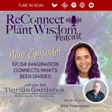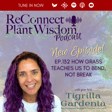
Ep.127 Tending the Wild City with Josh Harrison
Cities don’t have to fight nature—they can breathe with it.
In this conversation with artist–ecologist Josh Harrison, we explore cities as living ecosystems: cooling with plants, capturing stormwater, and designing with indigenous stewardship in mind.
We go beyond “green decor” to talk symbiogenesis, circular materials, and what shifts when we remember: I am nature, and I have a role to play.
You’ll leave with fresh language, grounded examples, and a clearer sense of how to tend your place—on the street you live.
What You’ll Learn About Ecoliving & Urban Ecology
🌱 Why urban rewilding works: evapotranspiration, shade, and soil as climate tech
🌱 How indigenous fire and tending create resilience (not chaos)
🌱 A practical look at green roofs, bioswales, and circular materials (upcycled “soil”)
🌱 The mindset reframe from “humans vs. nature” to “we are nature”
✨ Resources ✨
🌱 Expanded Show Notes
🌱 Leaf Island (green roof & circular soil innovation)
🌱 Kat Anderson, Tending the Wild
🔗 Connect & Explore More
🌿 Website
🌿 Contact
🌿 Shop Eco-Conscious Partners
Socials
📸 Instagram
📘 Facebook
💼 LinkedIn
▶️ YouTube
🎵 Credits
Opening + Closing music by @Cyberinga and Poinsettia



















